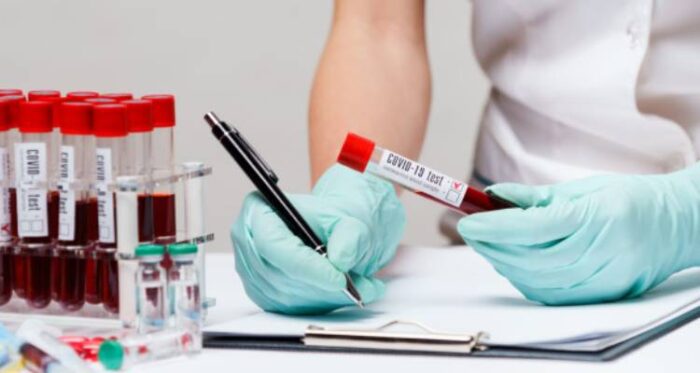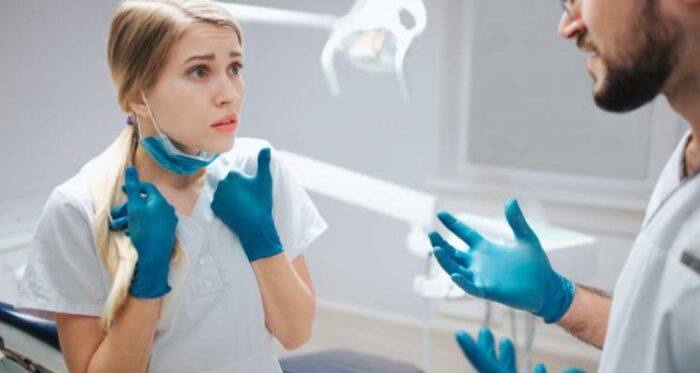It may be disturbing to see a black spot or dot within your cheek, but not usually a symptom of something significant.
Several harmless disorders, including moles, hyperpigmentation, and leakage from dental filling, may induce discoloration in your teeth.
Black Spot Inside Cheek
A black spot may be an example of a form of cancer named oral melanoma in exceptionally unusual Trusted Source instances.
According to The Oral Cancer Foundation, oral melanoma accounts for about 1.6% of head or neck cancers and fewer than 1% of all melanomas.
Continue reading to determine what can trigger a black spot within your cheek, and when your doctor should be seeing.
Causes of a Black Spot Inside Cheek
The Black Spot Inside Cheek Several factors can create dark spots in your mouth.
They go from minor bruises to benign cancers in your blood vessels, such as haemangiomas, such as a dye from a tooth filling that has spilled into your gums (called an amalgam tattoo).
The Smoker’s melanosis

Smoking may leave dark flakes in the cheeks and other parts of the mouth, for example, gums.
According to research published in case reports in dentistry, this disease is called Smoker’s melanosis, and about 22% of smokers may experience this form of discoloration in their teeth.
The nicotine stimulates unnecessary concentrations of melanin in the mouth’s inner lining, which produces a deeper pigmentation.
Patients should consider stopping the other oral consequences of nicotine usage when the disease is benign.
[READ Shortness of Breath After Quitting Smoking ]
The Amalgam Tattoos

If the spot inside your cheek is dark blue, grey, or black, the dental filling can leak. Amalgam tattoos are not permanent decorations in pigment as you would do in a tattoo room on the skin.
Amalgam is the dentist’s silver material for filling cavities, and it consists of a combination of tin, zinc, mercury, copper, and silver.
Often the filling of the mixture spills after the dentist has filled a tooth and leaves behind a smooth, painless dark spot that does not expand or alter form.
According to Brigham and the Division of Oral Medicine and Dentistry of Women’s College, tattoos are irreversible but not dangerous.
It’s doubtful anyone can notice it if the symbol is within your cheek. If you find the place seems unexpected, though, chat to your dentist regarding removal choices.
[READ What Happens if I Don’t Brush My Teeth]
The Peutz-Jeghers syndrome
Peutz-Jeghers Syndrome is a disorder that induces non-cancerous growths called bowel and stomach polyps.
Children who have this disease also develop black patches on their tongues, mouths, eyes, nose, and anus. Usually, the spots disappear with age.
Complications, including nausea, bleeding, or bowel obstruction, also sometimes occur in individuals with Peutz-Jeghers syndrome.
There is currently no remedy for Peutz-Jeghers syndrome, although surgeries will eliminate the digestive tract’s polyps.
Other Causes of a Dark Spot Inside the Cheek
The Dark spot is also known as Dark Spot. If you have a dark mark on your eye, it may be cancerous instantly. Know, this is not probable to be the case, and care might not be needed.
The Oral Cancer Foundation reports many sources of dark spots inside cheeks that are not cancer-linked. E.g., your cheek’s inner lining can be patchy pigmented.
You may have a benign melanotic macule, which is like a freckle in the oral cavity.
Otherwise, if you have already had pencils on your lips, the graphite could have been integrated into your mouth and formed a dark mark.
A black or dark patch within the cheek could very occasionally be a symptom of oral malignant melanoma or any form of oral cancer.
Therefore, the dentist can still be seen whenever you find an odd position in your mouth that doesn’t go, bleeds or gets more significant. Your dentist will diagnose the source of the black spot by inspecting and taking a sample for examination.
Having a regular oral regimen will reduce the worries of a dark spot on your eye. Besides cleaning the teeth twice a day and flossing once a day, check the mouth daily to ensure that the gums and cheeks are safe.
Tell your dentist of any problems or signs, then work together to find a cure.
Causes of a Black Dot Inside Cheek

It may be disturbing to look in the mirror and see a black mark on the cheek, but is it a serious thing?
The good news is that a dark spot on your cheek may be innocuous. Find these potential causes, and for a conclusive diagnosis, see the dentist.
Several harmless disorders, including moles, hyperpigmentation, and leakage from your dental fillings, can induce discoloration in your mouth.
On the inside of your cheek, the following conditions can cause a black dot, a tiny, circular mark, to appear.
The Oral Nevi
Tiny orange, bluish-grey, or nearly black spots that may occur within your mouth are oral nevi. Nevi is a medical concept (nevus is singular) for moles.
Oral nevi usually are elevated slightly. They’re more common on the roof of the mouth or inner lip, but they can also form on the cheeks. Typically, they don’t cause signs.
No medication for the oral nevus usually is required, and no cases of the oral nevus being cancerous are reported.
However, to ensure that it is just a nevus and not a melanoma, the doctor or dentist can also consider having a biopsy.
The Blood Blister

Blood blisters are fluid sacs that are overflowing with blood. They can vary from purple to dark red.
When the skin in your mouth gets pinched, they usually develop. Blood blisters are also large enough that the tongue helps you to feel them.
They most frequently type, like your cheek or inner lips, on the sensitive areas of your mouth. Usually, they are painful when touched or if you eat spicy food.
If you let them alone, the rest of the blood blisters don’t last long and don’t require care.
But it’s a smart idea to see the doctor if the blood blister persists for longer than two weeks or becomes a recurrent issue.
[READ What Foods Cause Blood Clots ]
Dental Filling Leaky
Amalgam fillings have been widely used in dentistry to repair decayed teeth for many years. Many elements, including copper, tin, mercury, zinc, and silver, are made of dental amalgam.
Unfortunately, they will leak as these fillings get aged and allow a dark blue, purple, or black color to stain the underlying tissues.
Such stains are permanent and are known as tattoos of amalgam. The lining would either need to be fixed or removed to stop other problems if the dentist thinks a leaky lining is a dark spot.
Melanotic macules
The regions of hyperpigmentation that average about a quarter of an inch in diameter are oral melanotic macules. They can be up to 0.04 of an inch. These spots are usually smooth and have a perimeter that is well-defined.
In the case of Black Spot Inside Cheek, Oral melanotic macules are non-cancerous, so the doctor could advise a biopsy to rule out melanoma.
The Certain Medical Conditions
In some cases, certain medical conditions such as Peutz-Jeghers syndrome or Addison’s disease can cause dark spots in the mouth.
In these cases, a visit to your primary care physician will be needed to confirm the diagnosis and get the right treatment.
Addison’s disease can Cause Dark Spot
Addison disease or adrenal insufficiency is a hormone imbalance developed by the adrenal glands.
Hyperpigmented blots of skin in the mouth are one of the signs of Addison’s disease.
Additional signs include:
- severe fatigue.
- Loss in weight
- Cravings of Salt
- Blood sugar is poor
- pigmentation
You may take drugs to replace hormones that cannot be generated by your adrenal gland.
When to See a Specialist Doctor

Although the odds of contracting oral melanoma are very slim, visiting your doctor is a safe idea when you find an abnormally colored spot or point in your mouth.
It is exceptionally critical that you search the place if you are 55 years old or older. Older people are most prone to experience oral cancer.
To Diagnose the Cause
To help validate the diagnosis of the dark spot within your cheek, your doctor can use the following tests: Black Spot Inside Cheek physical check-up. During a physical exam, the doctor can distinguish the location quickly based on its presence.
Biopsies. Your doctor will break off a little slice of the spot after a biopsy and give it to a lab for examination. Test with blood. If you suspect Addison’s disease, your doctor can prescribe a blood test that tests your potassium, cortisol, and ACTH hormone levels.
People Most Ask Able Questions & The Specialist Doctors Answers about black dot inside cheek
Q1: My husband has a black spot beneath his tongue on the very back. Will that be cancer?
Doctor Answer: Several factors can cause dark spots in your teeth. They vary from mild damage to benign cancers in the blood arteries, including haemangioma, such as a smear of a dental lining spilled through your gums (called an amalgam tattoo).
Few cancer forms can also present as dark spots. E.g., melanomas (skin cancers) appear like dark spots.
While most people still equate melanomas with exposed areas of the face, they can also appear in the mouth and even inside the nose and sinuses (areas that are not exposed to the sun).
Your husband should test this region by a specialist to see whether more examination is required.
Q2. I have a tough pea lump in my cheek around my jaw (near my molars but not in my gums). I will pass it around. I can move it around. It’s typically really little. It swells up when I’m ill, but it doesn’t always hurt. I’m thinking about cancer. Cancer. What sort of physician can I see? What kind of tests am I possibly going to need?
Doctor Answer: Your primary practitioner or an ear, nose, and throat doctor will help you assess the bump.
The region you mention may be within the parotid gland or inside the upper neck’s lymph nodes.
The fact that it swells in the sick means that a lymph node is more probable. Because lymph nodes are more like filters in your body and support you in battle diseases, they get larger when you’re sick.
Possibly little to think about as long as it goes back to its usual size afterward. There may be several items in the parotid gland, like a benign tumor (non-carcinogenic). One way to diagnose what kind of mass is by slight suction of a needle.
In this process, a tiny needle is placed into the mass, and several cells are removed. The cells will then be tested under a microscope by a pathologist to assess the disease.
Q3.For months now, the back of my neck has troubled me. As I turn my neck, it seems like there’s something on top of my spine. I have been under many pressures lately and have only taken Advil (ibuprofen) about three days a week or, if appropriate, twice a day. Two days ago, I noticed a round red spot near my throat on the back of my mouth. This brought me to some concern because I was smoking sometimes. I quit right now because I noticed it. My throat was sore, and I had it tested for strep, but it got negative. My concern is how does mouth cancer look? May I be interested? I’m so anxious.
Doctor Answer: Stress in our busy environment is a big challenge. There may be a lack of sleep, inadequate diet, and rising signs of tension, along with reduced immunity.
Bacterial, viral, and even fungi that usually reside in our mouth may grow oral lesions during stress cycles. Stress will also reduce the body’s capacity to repair slight injuries on the body’s jaw.
The mixture of these conditions may contribute to sometimes unpleasant and discolored lesions and ulcers. This type contains multiple cold sores and aphtha’s ulcers. In one to two weeks, these lesions should be cured.
Oral washing with dilute alcohol or saltwater should help avoid infection and can improve healing. Your doctor can assess any lesions that linger or bleed after two weeks.
Q4. Do spicy foods induce cancer of the mouth?
Doctor Answer: This is a powerful query I get from several of my patients who want “bam!” “For their bread. I have studied the topic on many occasions.
While several research is carried out on the function of some spices and spicy foods in reflux and esophagus disease, there is very little proof that the average intake of spicy foods can contribute to oral cancer.
The heavy intake of spicy foods is a possible risk factor for many broad population studies. However, there is seldom a single risk factor.
Sometimes these are the same categories of people who still cigarette and drink—known high-risk mouth cancer behaviors.
The natural response is that we don’t know if the link is clear. Part of the dilemma is that what we are talking about, “spicy foods,” cannot be generalized since it may differ considerably from individual to person, culture to culture.
Latest findings have shown that consuming a broad range of foods – including whole grains and green leafy vegetables – and diminishing fatty foods intake will contribute to lower incidences of several forms of cancer. Weight reduction is beneficial in reducing the incidence of cancer.
So the most excellent suggestion I can offer is to hear what your mother said: eat right. Eat multiple plants. Eat some plants. Don’t consume too many. Don’t eat too many.
Get a lot of workouts. And don’t drink. Don’t smoke. Everything in balance — including the sometimes spicy dinner.
Q5. Can X-rays raise the salivary gland cancer risk? If so, can I restrict the number of X-rays that I get in general dental care?
Doctor Answer: High doses of ionizing radiation have demonstrated that certain tumors, including skin, soft tissue (sarcoma), bone, and thyroid, raise the risk.
These results are seen years and decades following initial therapy. Thus, adults who undergo extensive doses of radiation in infancy are more at risk, typically for childhood cancer care, such as lymphoma or leukemia. The relation between radiation exposure and danger is obvious.
Dental X-rays include a comparatively minimal dosage of radiation, but most patients have a low chance of contracting cancer-related to regular dental X-rays. However, if you are interested, you should still recommend that other areas of the body be protected with lead safety during these procedures.
Early Signs of Oral Cancer and Symptoms
Early Signs of Oral Cancer – Oral Cancer Symptoms Explained By Dr. Sameer.
Conclusion
It is doubtful that a dark spot or stain would be a symptom of cancer in your mouth. But revealing that to the doctor or dentist is always a smart thing. If it turns out to be cancerous, early detection and care will boost your view.
READ THIS NEXT
Benefits of Using Conditioner Before Shampoo
How to Drink Matcha Tea for Weight Loss
How Much Weight Loss Surgery Cost
What Is The Best Skincare Routine For Men
How to Build Your Immune System to Fight HPV
What Happens if I Don’t Brush My Teeth
Psychological effects of being lied
